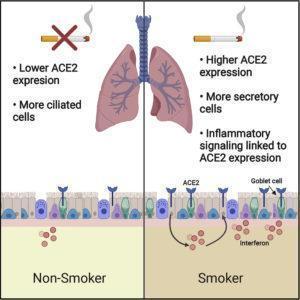Similar to related coronavirus that emerged in 2003 (1), SARS-CoV-2 enters human cells by binding to the extracellular domain of Angiotensin Converting Enzyme 2 (ACE 2) (2, 3). ACE 2 normally functions in the renin-angiotensin system (RAS) by cleaving the vasoconstrictive hormone angiotensin-II into the vasodilator angiotensin (4). Sequestration of ACE 2 by coronavirus dysregulates the RAS pathway, contributing to morbidity (5). Additionally, modulation of ACE 2 levels is capable of influencing disease progression, e.g. mice engineered to express human ACE 2 mRNA exhibited short survival time following coronavirus exposure (6). Thus, suggesting that regulation of ACE 2 expression likely has a significant effect on SARS-CoV-2 susceptibility.
Smith, et al., showed that cigarette smoke causes a dose-dependent upregulation of ACE-2 in rodent and human lungs. Using single-cell sequencing data, they demonstrated that ACE 2 is expressed in a subset of epithelial cells that line the respiratory tract, including goblet cells, club cells, and alveolar type 2 cells. They showed that cigarette smokers harbor consistently higher levels of ACE-2 in their lungs compared to non-smokers. In contrast, quitting smoking causes a decrease in lung ACE-2 levels. The overabundance of ACE 2 in the lungs of smokers may partially explain why smokers are significantly more likely to develop severe SARS-CoV-2 infections that require aggressive medical interventions (8).
Upregulation of ACE-2 in smokers could be a protective mechanism to prevent lung damage in smokers. However, when a smoker is exposed to SARS-CoV-2 higher ACE-2 expression may facilitate increased viral entry and replication. Taken together, these results may partially explain why smokers are particularly likely to develop severe SARS-CoV-2 infections, and they suggest that quitting smoking could lessen coronavirus susceptibility.
Journal Article: Smith, J. C., et al., (2020). Cigarette smoke exposure and inflammatory signaling increase the expression of the SARS-CoV-2 receptor ACE2 in the respiratory tract. Developmental Cell
References
- Li, W. et al. Angiotensin-converting enzyme 2 is a functional receptor for the SARS coronavirus. Nature 426, 450454 (2003).
- Zhou, P. et al. A pneumonia outbreak associated with a new coronavirus of probable bat origin. Nature 579, 270–273 (2020).
- Hoffmann, M. et al.SARS-CoV-2 Cell Entry Depends on ACE2 and TMPRSS2 and Is Blocked by a Clinically Proven Protease Inhibitor. Cell (2020) doi:10.1016/j.cell.2020.02.052.
- Zhu, N. et al.A Novel Coronavirus from Patients with Pneumonia in China, 2019. NEJM 382, 727–733 (2020).
- Kuba, K. et al.A crucial role of angiotensin converting enzyme 2 (ACE2) in SARS coronavirus – induced lung injury. Nature Medicine11, 875– 879 (2005).
- McCray, P. B. et al.Lethal Infection of K18-hACE2 Mice Infected with Severe Acute Respiratory Syndrome Coronavirus. Journal of Virology 81, 813–821 (2007).
- Wu, Z. & McGoogan, J. M. Characteristics of and Important Lessons From the Coronavirus Disease 2019 (COVID-19) Outbreak in China: Summary of a Report of 72 314 Cases From the Chinese Center for Disease Control and Prevention. JAMA (2020) doi:10.1001/jama.2020.2648.
- Guan, W.-J. et al. Clinical Characteristics of Coronavirus Disease 2019 in China. NEJM (2020) doi:10.1056/NEJMoa2002032.
Article by Naffesa Al Sheikh











